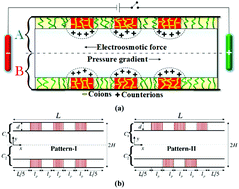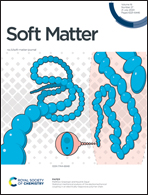Efficient electroosmotic mixing in a narrow-fluidic channel: the role of a patterned soft layer†
Abstract
We propose a novel and efficient mixing technique in a soft narrow-fluidic channel under the influence of electrical forcing. We show that a grafted polyelectrolyte layer (PEL) added as a patch to the channel wall modulates the electrical double layer (EDL) so that an applied electric field initiates a local electroosmotic flow (EOF) at the patched section. This EOF develops in the opposite direction to the primary pressure-driven flow. This localized EOF leads to the formation of Lamb vortices at the patched sections through the phenomenon of momentum exchange with the primary stream and promotes the mixing therein. Our study, consistent with the stream-function/vorticity approach, primarily focuses on the numerical analysis of the mixing phenomena. Through a quantitative description, we reveal the effect of different patterns on the underlying mixing phenomena in the convective mixing regime. We also discuss the impact of key parameters on the mixing efficiency, the onset of the recirculation zone, variation in the mixing length, and the shear-driven aggregation kinetics in soft matter systems. Finally, considering the practicability of the present problem, we unveil the values of several design parameters for which the mixing efficiency in the channel reaches the maximum.



 Please wait while we load your content...
Please wait while we load your content...